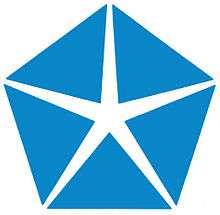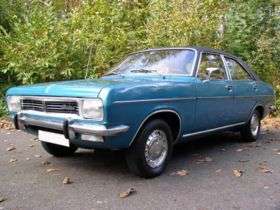Chrysler Europe
 | |
| Subsidiary | |
| Industry | Automotive |
| Fate | Taken over |
| Predecessor |
Barreiros Rootes Group Simca |
| Successor |
PSA Peugeot Citroën Renault Trucks[1] |
| Founded | 1967 |
| Defunct | 1978 |
| Headquarters |
Whitley, Coventry, UK Poissy, France |
| Products | Automobiles |
| Parent | Chrysler Corporation |
| Subsidiaries |
Chrysler (UK) Chrysler (France) |
Chrysler Europe was a division of the American Chrysler Corporation automotive company. It was formed from the merger of the French Simca, British Rootes and Spanish Barreiros companies. Chrysler Europe operated between 1967 and 1979, before it was divested to PSA Peugeot Citroën.
For the first half of the 1980s the company and its products became known publicly as Talbot, before PSA abandoned the brand for passenger cars in 1986.
Today, the two remaining Chrysler Europe assets still in existence are the former Simca factory in Poissy, which survives as a major Peugeot-Citroën assembly plant, and the Rootes Group research and development complex in Whitley, Coventry - which is now the headquarters of Jaguar Land Rover.
Formation
Chrysler Corporation had never had much success outside North America, contrasting with Ford's worldwide reach and General Motors' success with Opel, Vauxhall, Holden and Bedford. Chrysler first established an interest on the French-based Simca in 1958, buying 15% of the Simca stocks from Ford. In 1963 Chrysler increased their stake to a controlling 63%[2][3] by purchasing further stock from Fiat.
Chrysler acquired a 35% share of the Spanish Barreiros in 1963,[4] and became part of Chrysler Europe in 1969.
After failing to acquire an interest in the British-based Leyland Motors in 1962, Chrysler bought a 30% share in Rootes Group in 1964,[5] Rootes was formally taken over by Chrysler following purchase of the remaining shares in 1967.[6]
In 1970 Rootes formally became known as Chrysler (UK) Ltd. and Simca became known as Chrysler (France).
Brands
Although the original marques were retained at first, from 1976 British-built cars were badged as Chryslers, while the Simca badge appeared on French versions (though with the Chrysler pentastar, in some markets the cars were sold as Chrysler-Simca). Chrysler used the Dodge marque on commercial vehicles produced by both Simca and Rootes (Commer and Karrier, but in addition using badge engineering to sell vehicles overseas under the Fargo and DeSoto brands). In addition, in some countries, such as Spain, the Dodge and Simca marques would be used for other vehicles, mostly Spanish-designed (ex-Barreiros) trucks and buses and locally-built versions of US-market vehicles or local versions of Simca cars.
The company systematically retired the previous marques from Rootes, including Hillman, Humber, and Sunbeam in favour of the Chrysler name. The Simca brand was retained in its native France, but the Simca vehicles themselves were usually branded as either Chrysler-Simca or simply Chrysler outside France. In 1969, Chrysler Europe closed a deal with French engineering group Matra Automobiles to jointly develop the Matra sports cars and subsequently sell them through the Simca dealer network (as Matra-Simca). Following the introduction of the 1970 Avenger, Chrysler showed little investment or interest in the technologically conservative Rootes line-up, concentrating instead on the advanced front wheel drive Simca models instead.
Models
The first European Chrysler was the Chrysler 180, launched in 1970. The 180 was the result of combining two projects that were previously being developed independently by Rootes and Simca.
The British car designer Roy Axe, who originally started his career with Rootes, was responsible for unifying the designs of the new European range starting with the 1975 Simca 1307 hatchback, which was sold in the UK as the Chrysler Alpine. It was voted European Car of the Year for 1976. The 1307/Alpine was a five-door hatchback with front-wheel drive, in a market sector which was still almost exclusively populated by rear-wheel drive saloons like the Ford Cortina/Taunus and Opel Ascona (Vauxhall Cavalier in the UK). Chrysler decided to keep the Hillman Hunter, a rear-wheel drive range of saloons and estates, in production for the UK market as a traditional alternative to the Alpine.
Three years later, the smaller Chrysler Horizon also won the award. This was a five-door front-wheel drive hatchback similar in concept to the Volkswagen Golf, but again it was launched at a time when many comparable cars were still sold as rear-wheel drive saloons, so the Avenger was kept in production alongside it.
In 1977 Chrysler launched the British-only Sunbeam, a three-door supermini hatchback which effectively replaced the Hillman Imp.
Chrysler commenced design on the replacement for the 180, which eventually became the Talbot Tagora under Peugeot's ownership on its launch in 1980.
-

Chrysler 180 (1970)
-

Chrysler Alpine (1975)
-

Chrysler Sunbeam (1977)
-

Chrysler Horizon (1978)
Locations
Chrysler UK had several plants in Coventry, including the Ryton assembly plant, the Stoke Aldermoor engine plant, the design, engineering and development site at Whitley and Hills Precision, the plastics factory in Canterbury Street, as well as the vehicle manufacturing plant at Linwood in Scotland.
Decline and sale to Peugeot
Confused branding resulted from trying to concurrently sell the mismatched pairing of the Simca and Rootes product families, contrasting heavily with the fortunes of archrivals Ford and General Motors - who had both successfully managed to weave together their previously independent British and German subsidiaries. Chrysler Europe profits failed to materialize, although Simca on its own had been consistently profitable during its tenure under Chrysler ownership. It was the ailing former Rootes Group operations which were to prove to be the ultimate downfall of the company. Chrysler was already in serious financial trouble back home in America, and were on the brink of bankruptcy. The company's incoming CEO, Lee Iacocca had shown little interest in the European market from the outset (just as he had done during his period in charge of Ford), and wasted no time in wielding the axe almost immediately.
In 1978, Chrysler Europe was sold for a nominal US$1 to PSA Peugeot Citroën, who took on the liability for the division's huge debts as well as its factories and product line, with the former Chrysler models in Britain and Simca models in France both using the revived Talbot marque from August 1979.[7]
The Linwood factory in Scotland was closed by Peugeot in 1981 after just 18 years in use, marking the end of Avenger and Sunbeam production. The Sunbeam was replaced by the Peugeot 104 derived, French-built Talbot Samba, but the demise of the Avenger left the Horizon as the only car of its size in the Talbot range. The Alpine spawned a saloon version, the Solara, in 1980.
But by 1987, the French giant had scrapped the Talbot marque on passenger cars due to falling sales - though retaining it for commercial vehicles until 1992. The car designed to succeed the Horizon became Peugeot 309 on its launch at the end of 1985, and in 1983, Peugeot sold its share in Matra together with the Chrysler-initiated design of an MPV to Renault, where the design lives on as Renault Espace. Production of the Samba and Alpine/Solara finished in May 1986, while the Horizon remained in production in Spain and Finland until 1987; French and British production had finished during 1985 when the Peugeot 309 went into production.
Peugeot took little interest in heavy commercial vehicles and the production of former British and Spanish Dodge models passed to Renault Trucks. The Rootes factory in Dunstable, England ceased manufacture of trucks, ending with the Renault Midliner in the mid 1990s. In 2009 the staff of Renault Trucks (RVI), part of the Volvo Group since 2001, relocated from the former Rootes site to a new building. The former factory has since been demolished.
Chrysler on the other hand, retained the design rights to the Avenger and those of the US-version Horizon. Peugeot were therefore compelled to retain the Chrysler "pentastar" badge on the Avenger, whilst Chrysler prepared to shift production of the car to Argentina when European sales ended in 1981. The American version of the Horizon continued to be produced in the United States as the Plymouth Horizon and Dodge Omni until 1990, three years after the last European model was made.
The former Simca and Rootes assembly plants in Poissy and Ryton-on-Dunsmore, respectively, continued under the ownership of Peugeot, but Rootes' Linwood plant in Scotland was a casualty of the takeover - closing its doors in 1981. The former Rootes Ryton plant was closed in December 2006, with production of the Peugeot 206 (made there since the summer of 1998) moved to Slovakia. Since 1985, it had also produced Peugeot's 309, 405 and 306 ranges. It has since been demolished to make way for new factories. The former Rootes research and development site in Whitley was sold to Jaguar in 1986, and continues as the headquarters of Jaguar Land Rover to the present day. The former Simca site in Poissy has also thrived, and is now one Peugeot's most important assembly plants.
References
- ↑ Kuipers, J. F. J. (1983). Great Trucks. Beekman House. p. 9. ISBN 0-517-38114-1.
- ↑ "Chrysler buys French auto firm". St Petersburgh Times. 1 February 1964. p. 8. Retrieved 8 February 2014.
- ↑ "Project Car Hell, Chrysler Captives Edition: Simca 1204, Dodge Colt, or Plymouth Cricket?". Autoweek. 31 May 2013. Retrieved 8 February 2014.
- ↑ "Chrysler buys one-third of Spanish Auto Builder". St Petersburgh Time. 2 October 1963. p. 5-C. Retrieved 8 February 2014.
- ↑ Hyde, Charles (2003). Riding the Roller Coaster: A History of the Chrysler Corporation. Wayne State University Press. p. 199. ISBN 9780814330913.
- ↑ "Hillman Imp: The car that drove Linwood to disaster". BBC History. 1 May 2013. Retrieved 8 February 2014.
- ↑ "Development of the Chrysler - Talbot - Simca Horizon". Rootes-chrysler.co.uk. Retrieved 2011-11-28.
